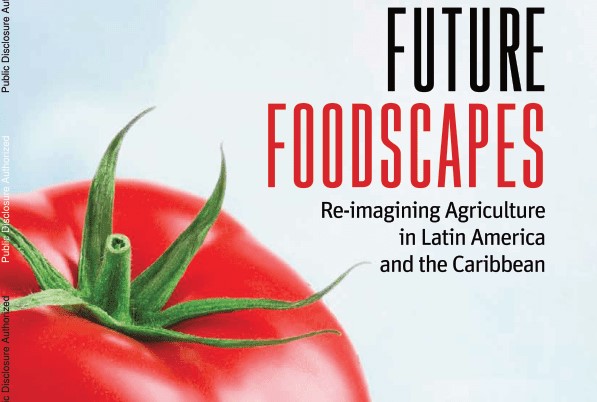BRIDGETOWN — Agriculture and food systems in Latin America and the Caribbean Region (LAC) stand at a crossroads. The declining visibility to public policy makers of farming and ranching in the rapidly urbanizing region has contributed to the perception that agriculture has diminished in importance and that attention can safely shift to other priorities.
This perception is misguided: the role played by agriculture has not diminished. On the contrary, agriculture and food systems make vital contributions to a diverse set of development objectives, including growth, poverty reduction, food and nutrition security, and climate resilience. As this report highlights, the forces shaping the evolution of agriculture and food systems in LAC are creating exciting opportunities to promote transformational changes, the effects of which will be felt at multiple levels: nationally, regionally, and globally.
What happens in LAC agriculture and food systems matters for economies within the region, but it also matters worldwide. LAC agriculture and food systems are the source of two important global public goods. First, LAC is the world’s largest net food-exporting region, and LAC agricultural exports help to stabilize food supplies and reduce food price volatility worldwide. In early 2020, the novel coronavirus (COVID-19) pandemic sparked an unprecedented humanitarian and economic crisis that devastated lives and livelihoods worldwide. The crisis put more than a quarter of a billion people around the world at risk of suffering acute hunger within 12 months, including hundreds of millions in LAC who fell into poverty and suffered devastating socio-economic consequences. Disruptions to global food supplies linked to the COVID-19 pandemic drew attention to the importance of LAC as a major net exporter of food and pointed to new opportunities for promoting greater intra-regional economic cooperation, in terms of production, trade and technology. Second, LAC is the world’s largest provider of ecosystem services. The Amazon basin, the forests of Central America, and other biomes in the Andean region and in the Southern Cone host vast stores of biodiversity, sequester huge amounts of carbon, and perform atmospheric regulatory functions that affect weather patterns worldwide. LAC will continue to produce these two global public goods only if the region’s agriculture and food systems evolve in ways that avoid threatening them and that capitalize on opportunities. If the complex tradeoffs between growing the economy, reducing poverty, feeding the population, improving nutrition, safeguarding human health, and preserving natural capital are not managed successfully in LAC, the cost to humanity will be extremely high.
1.1 Objectives of the report
The purpose of this report is to improve understanding of the transformational opportunities offered by LAC’s agriculture and food systems to contribute to growth, employment, and food and nutrition security while sustaining the region’s natural capital endowments and helping to mitigate climate change. This will be achieved by describing how demand- and supply-side forces are transforming LAC’s agriculture and food systems, exploring how long-term trends and short-term disruptors could affect future performance, and identifying measures that policy makers can take to facilitate the emergence of dynamic modern agriculture and food systems capable of performing the multiple functions that are expected of them.
The report is forward-looking: it adopts a long-term perspective and considers a time horizon up to 2030. The time line was chosen to extend far enough into the future to allow for the sector’s potential transformation in the region, factoring in the impact of ongoing trends and potential disruptions, but not so far as to lie beyond the sight line of today’s policy makers. The chosen horizon, furthermore, aligns with the Sustainable Development Goals (SDG) agenda set forth by the United Nations for the global community to meet in the coming decades, which identifies specific targets to be met by 2030. The alignment is appropriate, because the future performance of LAC agriculture and food systems will directly influence the achievement of (or failure to achieve) a number of SDGs, due to the impact of agriculture and food systems on growth, employment, food and nutrition security, and the environment.
1.2 Organization of the report
Including the introduction, the report contains six sections. Section 2 takes stock of the recent performance of LAC agriculture and food systems, briefly summarizing the contribution of these systems to a diverse set of development objectives including growth, job creation, food and nutrition security, and ecosystem sustainability. Section 3 considers the governance of LAC agriculture and food systems, assessing the effectiveness of public policies and supporting investments to achieve desired performance outcomes. Section 4 discusses the drivers that shape the evolution of agriculture and food systems, distinguishing between trends (slow-moving demographic, technological, and economic forces whose impacts will be felt gradually) and disruptors (fast-moving and often unexpected forces, such as technology breakthroughs or policy changes, that could lead to rapid change). Section 5 examines the road ahead, using scenario analysis to consider how future performance outcomes could be affected by the various drivers. Section 6 describes a series of proposed actions that can shape the transformation of agriculture and food systems to achieve outcomes that align with society’s long-term goals and offers some final thoughts about the road ahead.

